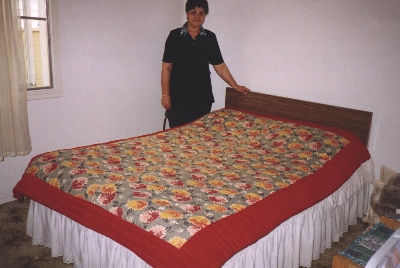Quilt No.921MP - Maria Patounas
2040 x 1670mm
The quilt was made c.1932 by a ' paplomatas' (quiltmaker) from Lindos on the Greek island of Rhodes. It was owned by Maria (Antonarakis) Stergakis and now belongs to her daughter Maria Patounas. It was used when the children were young but is not used now.
"Two Quilts from Lindos
Maria Patounas owns two 'paplomata' (quilts) - one was part of her mother's 'prika' (dowry), and the other, interestingly, was part of her father's prika! The wedding traditions of the Greek islands of Rhodes and Kastellorizon both include the groom sometimes bringing a prika to the marriage. It could include a 'kilimi' (woven rug), blankets and other items and a paploma. Often the groom would bring all this in his own 'baoulo' (chest or trunk). When the house was decorated in preparation for the wedding, there would be an area designated 'yia ton gambro' - for the groom.
The cotton used in these quilts was grown on Rhodes. Some of it came from the family's own fields in the village of Laerma near Lindos, well known for its ancient ruins. Growing up in Laerma, Maria remembers her extended family being almost entirely self sufficient - they owned sheep and bee-hives, grew wheat, olives, figs, pears, lentils and chick-peas. They made their own pasta, and baked their bread in the traditional 'fourno' (oven) situated outside the house. Maria recalls that 'sometimes we bought a bit of rice!
They were lovely days - that's why when we go to Greece, I love being in my village'.
Greece was ravaged by WWII and the civil war, and in the difficult years immediately following, huge numbers of Greeks migrated. With the two quilts in her luggage, seventeen year old Maria arrived in Brisbane to her fiance Panayioti, who had come two years earlier. Ten years later, her parents Despina and George Stergakis also took the difficult decision to migrate even though it was late in their life. They wanted to be near their children: Maria, Ioannis, Manolis and Stavroula, who eventually returned to live in Crete.
Maria and Panagioti married in 1962 in Brisbane's Greek Orthodox Church of St George, and settled into establishing themselves in their new country. They have three children - Paraskevi, George, and Anna."
[Written by Lula Saunders, adapted from interview 5/9/00 for the National Quilt Register]

Related Quilts:
2200 x 1840mm
1750 x 840mm
1960 x 1950mm
2033 x 1474mm






